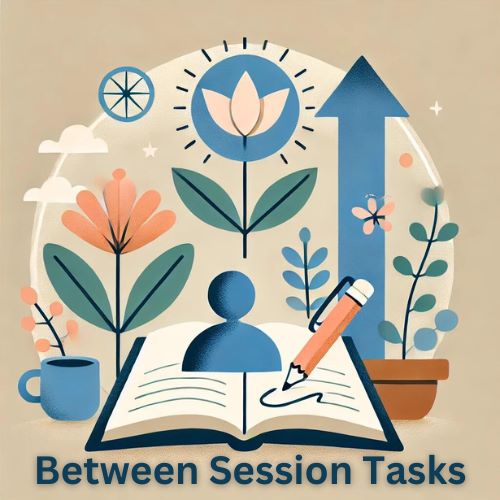Many people think that the core of therapy happens during the sessions with their psychologist. While these sessions are crucial, much of the meaningful change actually occurs between sessions through what we call “between-session tasks.” These tasks are designed to help you integrate what you’ve learned during your therapy sessions into your daily life, fostering real and lasting change.
Why Between-Session Tasks Matter
Consider this: there are 168 hours in a week, and a typical therapy session lasts just 50 minutes. This means that the majority of the work needs to happen outside of the therapy room. Between-session tasks allow you to apply new skills and insights in real-world situations, making your therapeutic progress more robust and effective. Research has shown that between-session tasks enhance the overall efficacy of therapy by reinforcing learning, increasing engagement, and fostering a sense of agency in clients. Reflect on this: How can integrating small, consistent changes in your daily routine potentially transform your therapy experience?
Types of Between-Session Tasks
The specific tasks you engage in will depend on your treatment goals and the areas you’re working on. Here are some common examples:
- Reading and Reflection: Early in therapy, you might be given articles or book chapters to read that expand on topics discussed in your sessions. This helps deepen your understanding and reinforces learning. Reflect on this: How can additional reading and reflection deepen your understanding of your own mental health?
- Self-Monitoring: Keeping track of specific behaviors, thoughts, or emotions can be incredibly illuminating. For instance, you might monitor your mood, sleep patterns, or instances of anxiety. This increased awareness is the first step toward change. Reflect on this: How can increased self-awareness through self-monitoring empower you to make more informed decisions about your mental health?
- Behavioral Experiments: You may be asked to try out new behaviors to test and challenge old patterns. For example, if you have social anxiety, a task might be to initiate a conversation with a colleague. Reflect on this: What small behavioral changes could you experiment with to challenge and change unhelpful patterns in your life?
- Cognitive Restructuring: Practicing techniques to identify and challenge negative thoughts can be a key part of between-session work. This might involve writing down negative thoughts and replacing them with more balanced ones. Reflect on this: How can challenging and changing your thought patterns influence your emotional wellbeing?
The Role of Self-Monitoring
Self-monitoring is a cornerstone of many therapeutic approaches. By keeping detailed records, you gain insight into patterns that may not be immediately obvious. This practice not only helps your psychologist understand your experiences better but also empowers you to take control of your progress. Research supports that self-monitoring enhances treatment outcomes by increasing clients’ insight and accountability. Reflect on this: What patterns in your thoughts, behaviors, or emotions have you noticed that could benefit from closer examination?
Reviewing Progress in Sessions
At the start of each therapy session, you will review your between-session tasks with your psychologist. This is an opportunity to discuss what worked, what didn’t, and why. Bringing your records to the session can make this process smoother and more productive. A dedicated folder for all your handouts, notes, and self-monitoring sheets can be very helpful. Reflect on this: How can regular review and feedback enhance your motivation and progress in therapy?
Setting New Tasks
Toward the end of each session, your psychologist will help you set new tasks for the upcoming week. These tasks should be directly related to what you discussed in your session and aligned with your overall treatment goals. It’s important to voice any concerns or uncertainties about the tasks, ensuring they are manageable and clearly understood. Reflect on this: How can collaboratively setting achievable tasks help you feel more confident and engaged in your therapeutic journey?
Making Time for Between-Session Tasks
It’s easy to forget about your between-session tasks once you leave the therapy room. To avoid this, schedule specific times each day or week to work on them. Setting reminders on your phone or marking your calendar can help keep these tasks a priority. Consistency is key—regularly working on your tasks will yield the best results. Reflect on this: How can incorporating scheduled time for self-care and between-session tasks into your routine improve your overall well-being?
Overcoming Challenges
If you encounter difficulties or forget to complete your tasks, don’t worry. The key is to be honest with your psychologist about what happened. This transparency allows for collaborative problem-solving and ensures you receive the support you need to overcome any barriers. Reflect on this: What challenges do you anticipate in completing your betweensession tasks, and how can you address them proactively?
Embracing Discomfort
Change often involves stepping out of your comfort zone. You might be asked to engage in activities that provoke anxiety or challenge deeply ingrained habits. Embracing this discomfort is part of the therapeutic process and essential for growth. Research indicates that exposure to and management of discomfort can lead to significant therapeutic gains. Reflect on this: How can embracing short-term discomfort lead to long-term benefits in your mental health journey?



